An Analysis of Project Management Methodologies: Agile and Waterfall
VerifiedAdded on 2023/01/23
|9
|1681
|92
Report
AI Summary
This report provides a comprehensive comparison of two prominent project management methodologies: Agile and Waterfall. It defines software development methodologies and highlights the key differences between Agile, characterized by its iterative and flexible approach, and Waterfall, a more traditional, sequential model. The report details the strengths and weaknesses of each methodology, examining scenarios where each is most effective. It explores the advantages of Agile for complex projects with changing requirements, while also acknowledging the benefits of Waterfall for projects with well-defined requirements. Furthermore, the report discusses the advantages and disadvantages of both methodologies, including considerations such as documentation, testing, and team structure. The use of Jira as a project management tool is also analyzed, emphasizing its role in enhancing project visibility, task prioritization, and overall productivity. The report concludes by offering insights into selecting the appropriate methodology based on project characteristics and organizational needs.
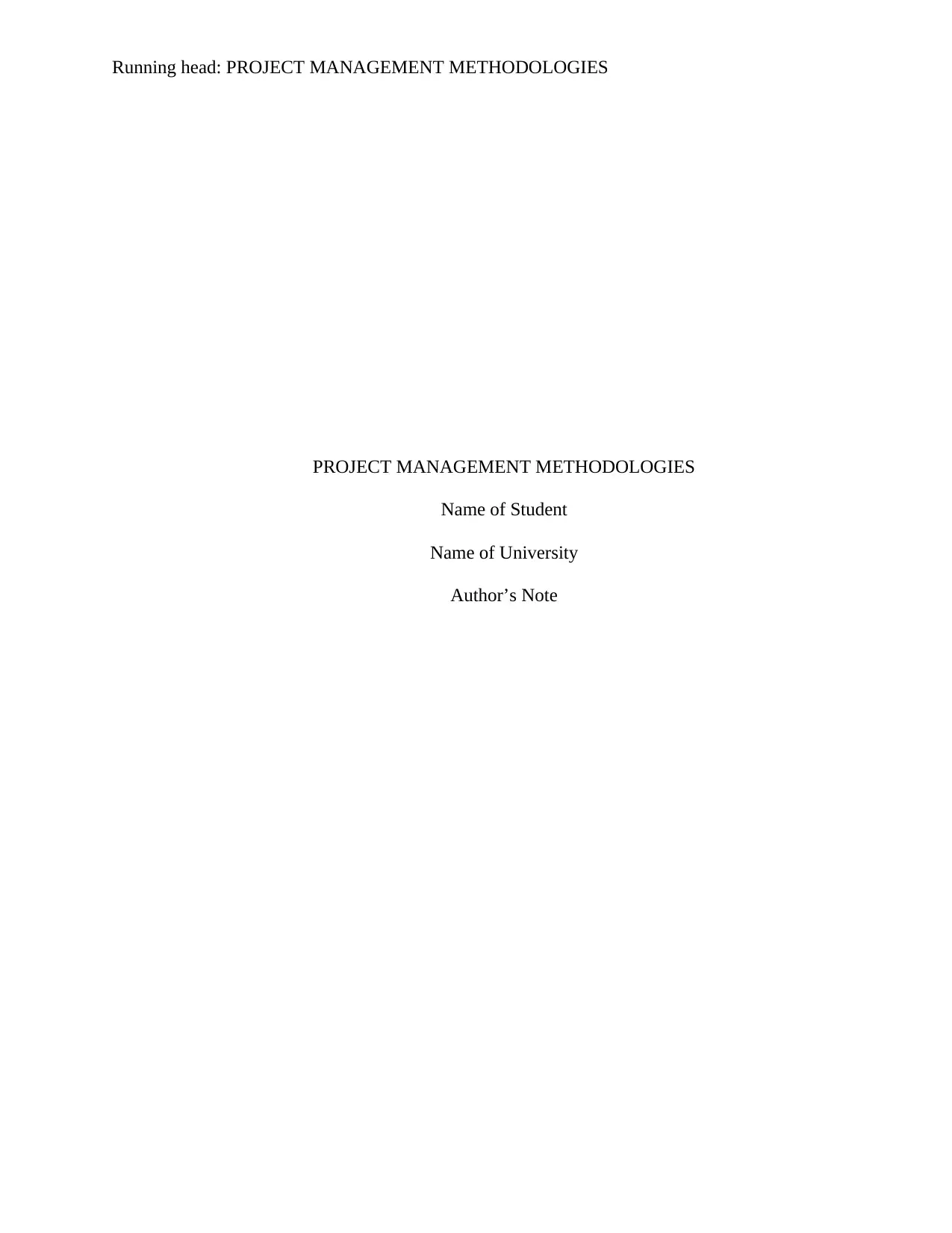
Running head: PROJECT MANAGEMENT METHODOLOGIES
PROJECT MANAGEMENT METHODOLOGIES
Name of Student
Name of University
Author’s Note
PROJECT MANAGEMENT METHODOLOGIES
Name of Student
Name of University
Author’s Note
Paraphrase This Document
Need a fresh take? Get an instant paraphrase of this document with our AI Paraphraser
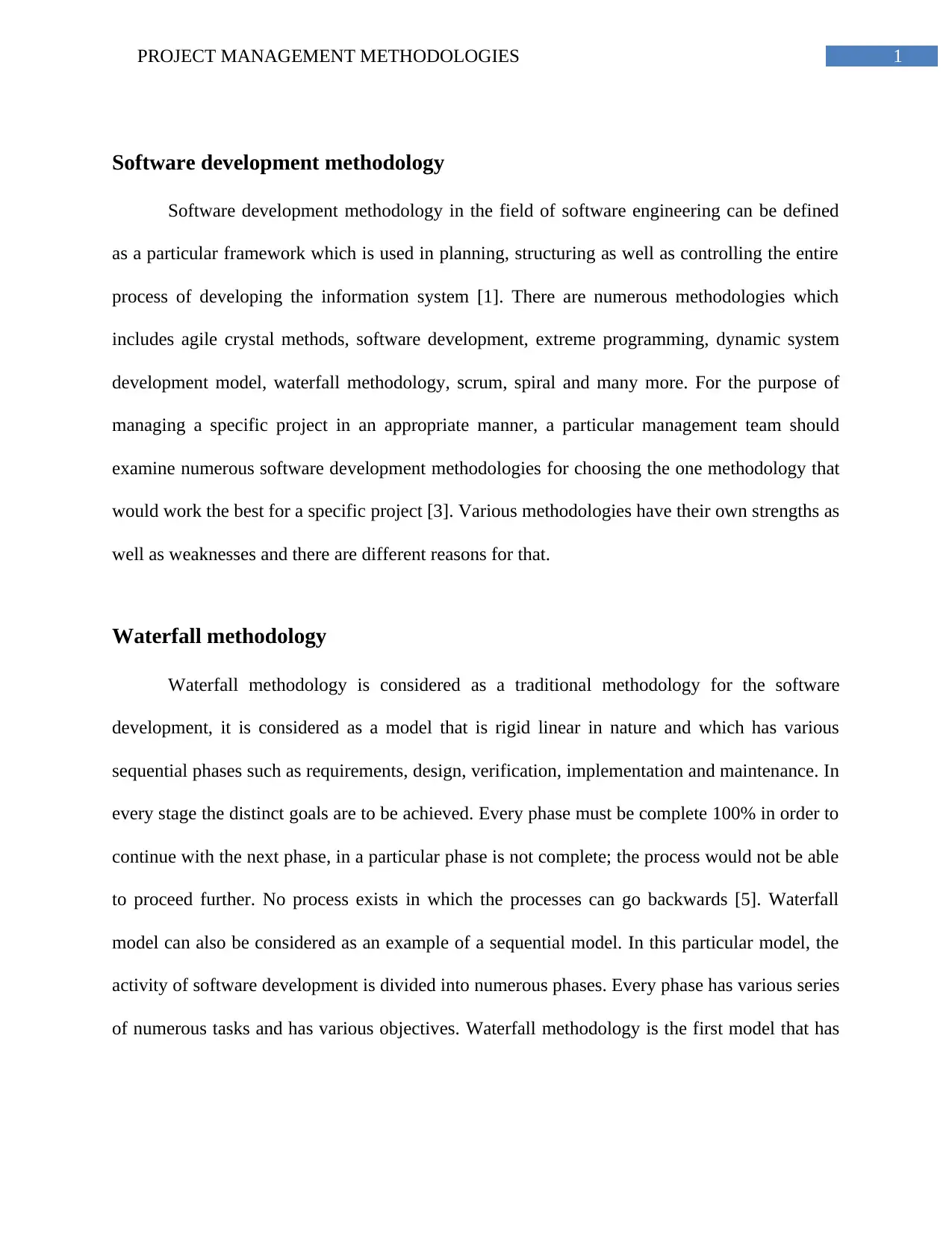
1PROJECT MANAGEMENT METHODOLOGIES
Software development methodology
Software development methodology in the field of software engineering can be defined
as a particular framework which is used in planning, structuring as well as controlling the entire
process of developing the information system [1]. There are numerous methodologies which
includes agile crystal methods, software development, extreme programming, dynamic system
development model, waterfall methodology, scrum, spiral and many more. For the purpose of
managing a specific project in an appropriate manner, a particular management team should
examine numerous software development methodologies for choosing the one methodology that
would work the best for a specific project [3]. Various methodologies have their own strengths as
well as weaknesses and there are different reasons for that.
Waterfall methodology
Waterfall methodology is considered as a traditional methodology for the software
development, it is considered as a model that is rigid linear in nature and which has various
sequential phases such as requirements, design, verification, implementation and maintenance. In
every stage the distinct goals are to be achieved. Every phase must be complete 100% in order to
continue with the next phase, in a particular phase is not complete; the process would not be able
to proceed further. No process exists in which the processes can go backwards [5]. Waterfall
model can also be considered as an example of a sequential model. In this particular model, the
activity of software development is divided into numerous phases. Every phase has various series
of numerous tasks and has various objectives. Waterfall methodology is the first model that has
Software development methodology
Software development methodology in the field of software engineering can be defined
as a particular framework which is used in planning, structuring as well as controlling the entire
process of developing the information system [1]. There are numerous methodologies which
includes agile crystal methods, software development, extreme programming, dynamic system
development model, waterfall methodology, scrum, spiral and many more. For the purpose of
managing a specific project in an appropriate manner, a particular management team should
examine numerous software development methodologies for choosing the one methodology that
would work the best for a specific project [3]. Various methodologies have their own strengths as
well as weaknesses and there are different reasons for that.
Waterfall methodology
Waterfall methodology is considered as a traditional methodology for the software
development, it is considered as a model that is rigid linear in nature and which has various
sequential phases such as requirements, design, verification, implementation and maintenance. In
every stage the distinct goals are to be achieved. Every phase must be complete 100% in order to
continue with the next phase, in a particular phase is not complete; the process would not be able
to proceed further. No process exists in which the processes can go backwards [5]. Waterfall
model can also be considered as an example of a sequential model. In this particular model, the
activity of software development is divided into numerous phases. Every phase has various series
of numerous tasks and has various objectives. Waterfall methodology is the first model that has
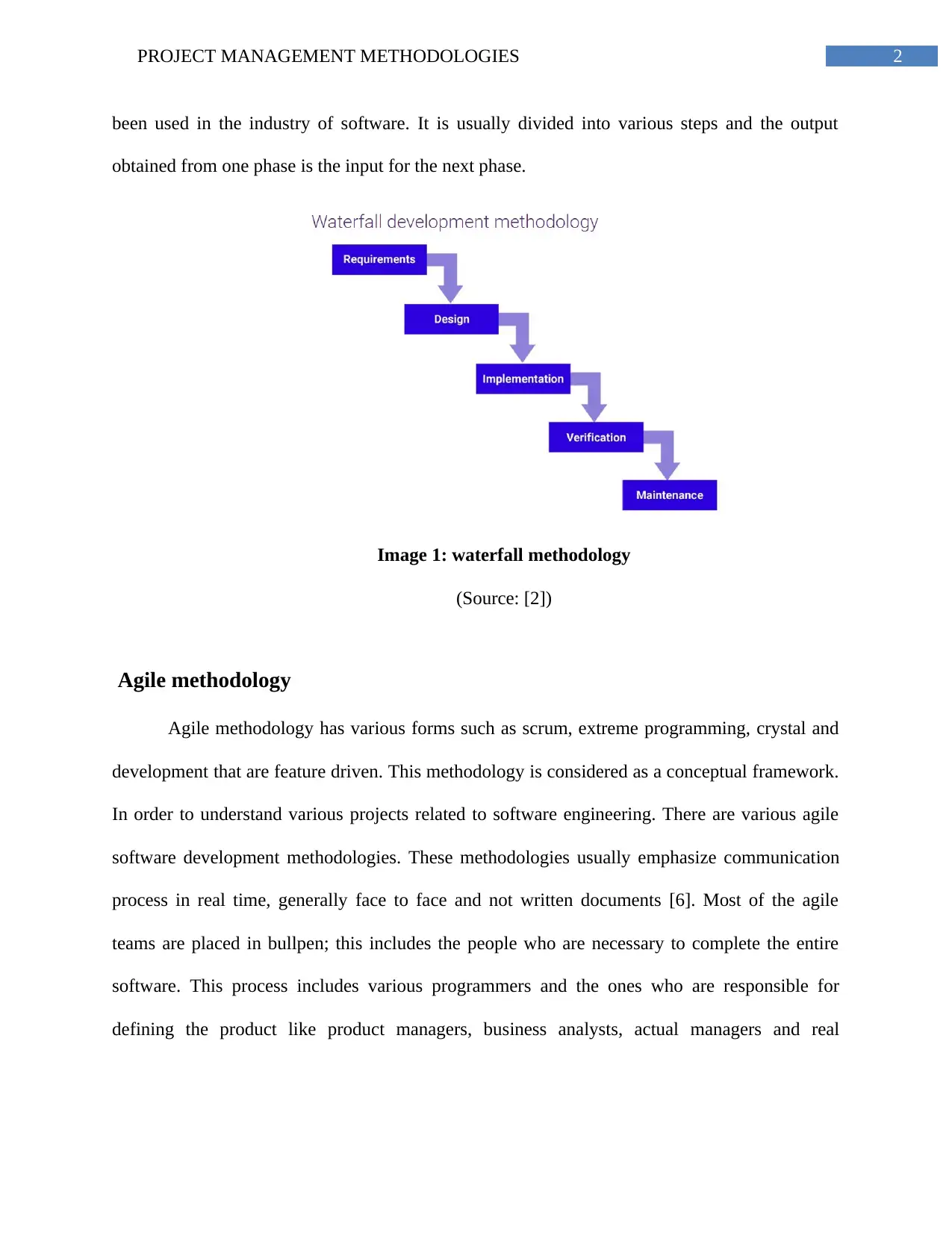
2PROJECT MANAGEMENT METHODOLOGIES
been used in the industry of software. It is usually divided into various steps and the output
obtained from one phase is the input for the next phase.
Image 1: waterfall methodology
(Source: [2])
Agile methodology
Agile methodology has various forms such as scrum, extreme programming, crystal and
development that are feature driven. This methodology is considered as a conceptual framework.
In order to understand various projects related to software engineering. There are various agile
software development methodologies. These methodologies usually emphasize communication
process in real time, generally face to face and not written documents [6]. Most of the agile
teams are placed in bullpen; this includes the people who are necessary to complete the entire
software. This process includes various programmers and the ones who are responsible for
defining the product like product managers, business analysts, actual managers and real
been used in the industry of software. It is usually divided into various steps and the output
obtained from one phase is the input for the next phase.
Image 1: waterfall methodology
(Source: [2])
Agile methodology
Agile methodology has various forms such as scrum, extreme programming, crystal and
development that are feature driven. This methodology is considered as a conceptual framework.
In order to understand various projects related to software engineering. There are various agile
software development methodologies. These methodologies usually emphasize communication
process in real time, generally face to face and not written documents [6]. Most of the agile
teams are placed in bullpen; this includes the people who are necessary to complete the entire
software. This process includes various programmers and the ones who are responsible for
defining the product like product managers, business analysts, actual managers and real
⊘ This is a preview!⊘
Do you want full access?
Subscribe today to unlock all pages.

Trusted by 1+ million students worldwide
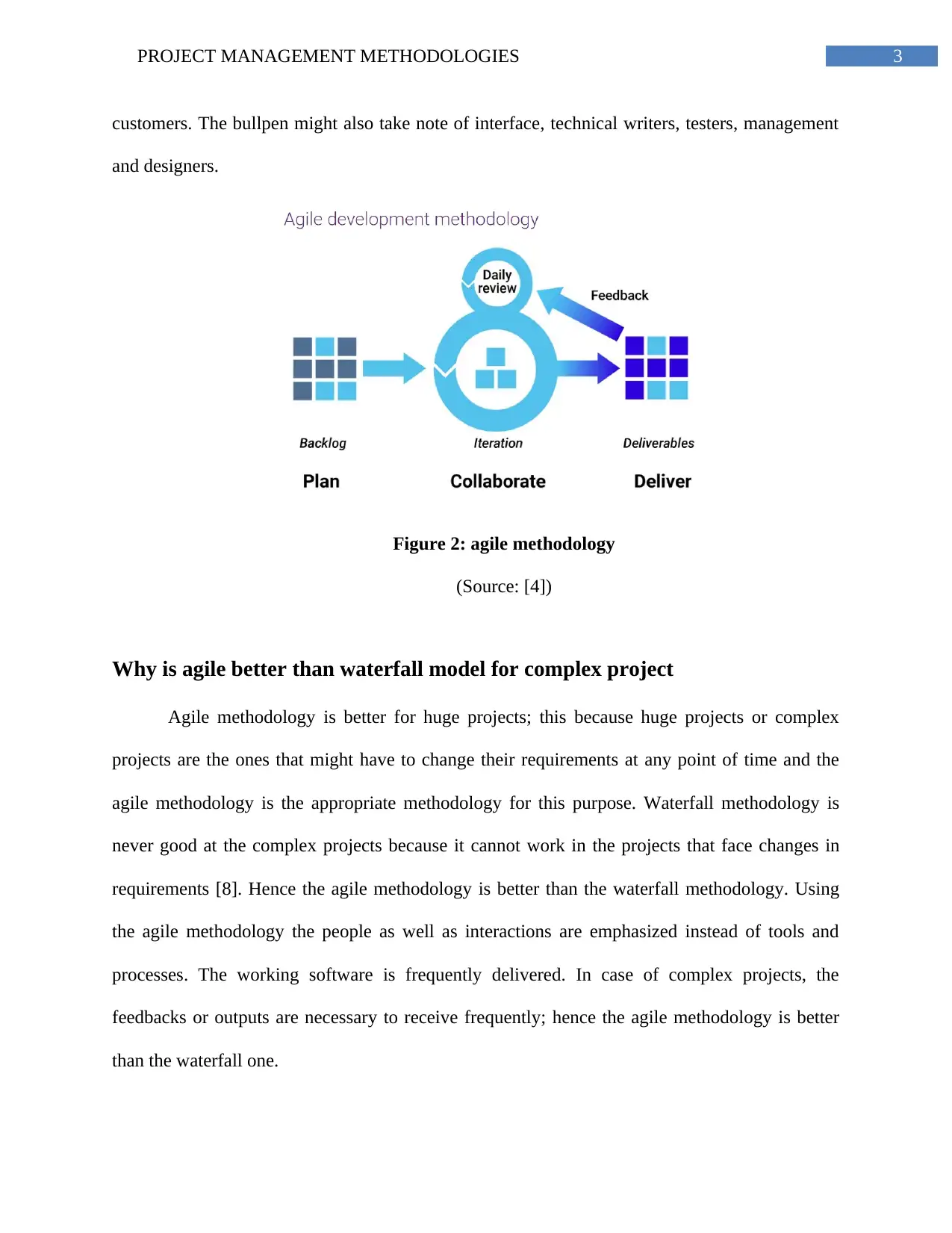
3PROJECT MANAGEMENT METHODOLOGIES
customers. The bullpen might also take note of interface, technical writers, testers, management
and designers.
Figure 2: agile methodology
(Source: [4])
Why is agile better than waterfall model for complex project
Agile methodology is better for huge projects; this because huge projects or complex
projects are the ones that might have to change their requirements at any point of time and the
agile methodology is the appropriate methodology for this purpose. Waterfall methodology is
never good at the complex projects because it cannot work in the projects that face changes in
requirements [8]. Hence the agile methodology is better than the waterfall methodology. Using
the agile methodology the people as well as interactions are emphasized instead of tools and
processes. The working software is frequently delivered. In case of complex projects, the
feedbacks or outputs are necessary to receive frequently; hence the agile methodology is better
than the waterfall one.
customers. The bullpen might also take note of interface, technical writers, testers, management
and designers.
Figure 2: agile methodology
(Source: [4])
Why is agile better than waterfall model for complex project
Agile methodology is better for huge projects; this because huge projects or complex
projects are the ones that might have to change their requirements at any point of time and the
agile methodology is the appropriate methodology for this purpose. Waterfall methodology is
never good at the complex projects because it cannot work in the projects that face changes in
requirements [8]. Hence the agile methodology is better than the waterfall methodology. Using
the agile methodology the people as well as interactions are emphasized instead of tools and
processes. The working software is frequently delivered. In case of complex projects, the
feedbacks or outputs are necessary to receive frequently; hence the agile methodology is better
than the waterfall one.
Paraphrase This Document
Need a fresh take? Get an instant paraphrase of this document with our AI Paraphraser
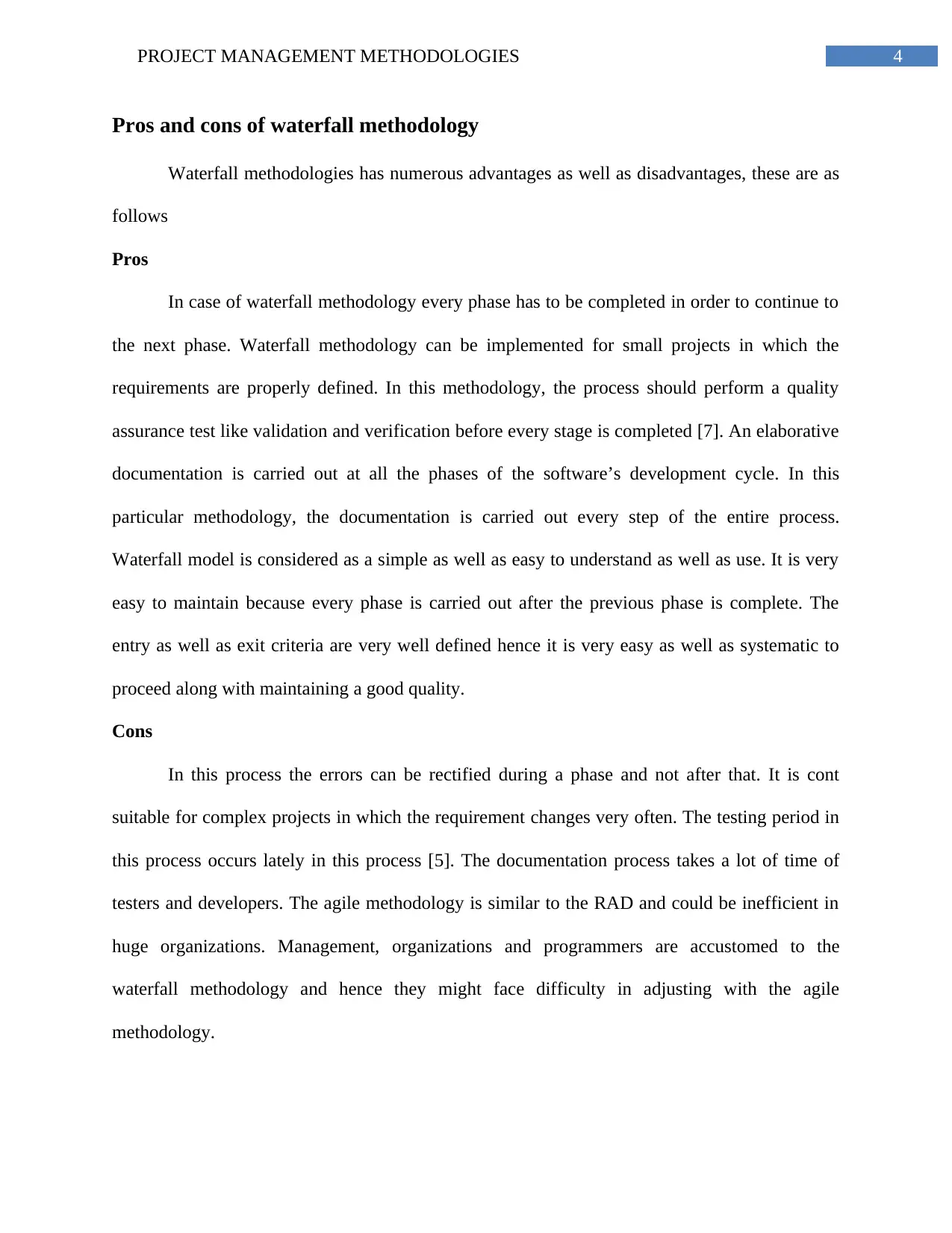
4PROJECT MANAGEMENT METHODOLOGIES
Pros and cons of waterfall methodology
Waterfall methodologies has numerous advantages as well as disadvantages, these are as
follows
Pros
In case of waterfall methodology every phase has to be completed in order to continue to
the next phase. Waterfall methodology can be implemented for small projects in which the
requirements are properly defined. In this methodology, the process should perform a quality
assurance test like validation and verification before every stage is completed [7]. An elaborative
documentation is carried out at all the phases of the software’s development cycle. In this
particular methodology, the documentation is carried out every step of the entire process.
Waterfall model is considered as a simple as well as easy to understand as well as use. It is very
easy to maintain because every phase is carried out after the previous phase is complete. The
entry as well as exit criteria are very well defined hence it is very easy as well as systematic to
proceed along with maintaining a good quality.
Cons
In this process the errors can be rectified during a phase and not after that. It is cont
suitable for complex projects in which the requirement changes very often. The testing period in
this process occurs lately in this process [5]. The documentation process takes a lot of time of
testers and developers. The agile methodology is similar to the RAD and could be inefficient in
huge organizations. Management, organizations and programmers are accustomed to the
waterfall methodology and hence they might face difficulty in adjusting with the agile
methodology.
Pros and cons of waterfall methodology
Waterfall methodologies has numerous advantages as well as disadvantages, these are as
follows
Pros
In case of waterfall methodology every phase has to be completed in order to continue to
the next phase. Waterfall methodology can be implemented for small projects in which the
requirements are properly defined. In this methodology, the process should perform a quality
assurance test like validation and verification before every stage is completed [7]. An elaborative
documentation is carried out at all the phases of the software’s development cycle. In this
particular methodology, the documentation is carried out every step of the entire process.
Waterfall model is considered as a simple as well as easy to understand as well as use. It is very
easy to maintain because every phase is carried out after the previous phase is complete. The
entry as well as exit criteria are very well defined hence it is very easy as well as systematic to
proceed along with maintaining a good quality.
Cons
In this process the errors can be rectified during a phase and not after that. It is cont
suitable for complex projects in which the requirement changes very often. The testing period in
this process occurs lately in this process [5]. The documentation process takes a lot of time of
testers and developers. The agile methodology is similar to the RAD and could be inefficient in
huge organizations. Management, organizations and programmers are accustomed to the
waterfall methodology and hence they might face difficulty in adjusting with the agile
methodology.
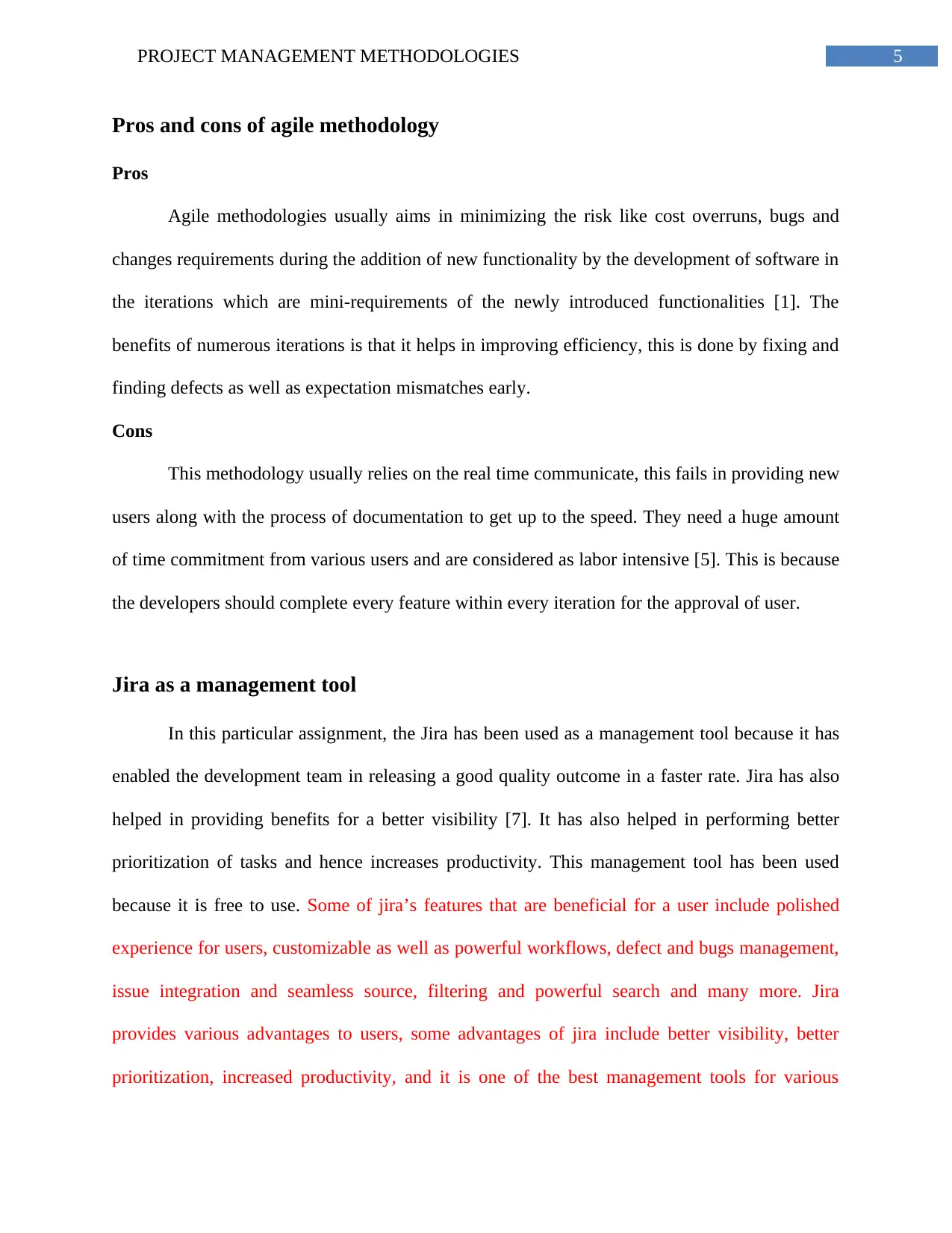
5PROJECT MANAGEMENT METHODOLOGIES
Pros and cons of agile methodology
Pros
Agile methodologies usually aims in minimizing the risk like cost overruns, bugs and
changes requirements during the addition of new functionality by the development of software in
the iterations which are mini-requirements of the newly introduced functionalities [1]. The
benefits of numerous iterations is that it helps in improving efficiency, this is done by fixing and
finding defects as well as expectation mismatches early.
Cons
This methodology usually relies on the real time communicate, this fails in providing new
users along with the process of documentation to get up to the speed. They need a huge amount
of time commitment from various users and are considered as labor intensive [5]. This is because
the developers should complete every feature within every iteration for the approval of user.
Jira as a management tool
In this particular assignment, the Jira has been used as a management tool because it has
enabled the development team in releasing a good quality outcome in a faster rate. Jira has also
helped in providing benefits for a better visibility [7]. It has also helped in performing better
prioritization of tasks and hence increases productivity. This management tool has been used
because it is free to use. Some of jira’s features that are beneficial for a user include polished
experience for users, customizable as well as powerful workflows, defect and bugs management,
issue integration and seamless source, filtering and powerful search and many more. Jira
provides various advantages to users, some advantages of jira include better visibility, better
prioritization, increased productivity, and it is one of the best management tools for various
Pros and cons of agile methodology
Pros
Agile methodologies usually aims in minimizing the risk like cost overruns, bugs and
changes requirements during the addition of new functionality by the development of software in
the iterations which are mini-requirements of the newly introduced functionalities [1]. The
benefits of numerous iterations is that it helps in improving efficiency, this is done by fixing and
finding defects as well as expectation mismatches early.
Cons
This methodology usually relies on the real time communicate, this fails in providing new
users along with the process of documentation to get up to the speed. They need a huge amount
of time commitment from various users and are considered as labor intensive [5]. This is because
the developers should complete every feature within every iteration for the approval of user.
Jira as a management tool
In this particular assignment, the Jira has been used as a management tool because it has
enabled the development team in releasing a good quality outcome in a faster rate. Jira has also
helped in providing benefits for a better visibility [7]. It has also helped in performing better
prioritization of tasks and hence increases productivity. This management tool has been used
because it is free to use. Some of jira’s features that are beneficial for a user include polished
experience for users, customizable as well as powerful workflows, defect and bugs management,
issue integration and seamless source, filtering and powerful search and many more. Jira
provides various advantages to users, some advantages of jira include better visibility, better
prioritization, increased productivity, and it is one of the best management tools for various
⊘ This is a preview!⊘
Do you want full access?
Subscribe today to unlock all pages.

Trusted by 1+ million students worldwide

6PROJECT MANAGEMENT METHODOLOGIES
reasons. Jira also provides various disadvantages; these disadvantages include the efforts
included in setup, it is difficult to use, there are some features that are missing and takes a lot of
time to develop.
reasons. Jira also provides various disadvantages; these disadvantages include the efforts
included in setup, it is difficult to use, there are some features that are missing and takes a lot of
time to develop.
Paraphrase This Document
Need a fresh take? Get an instant paraphrase of this document with our AI Paraphraser
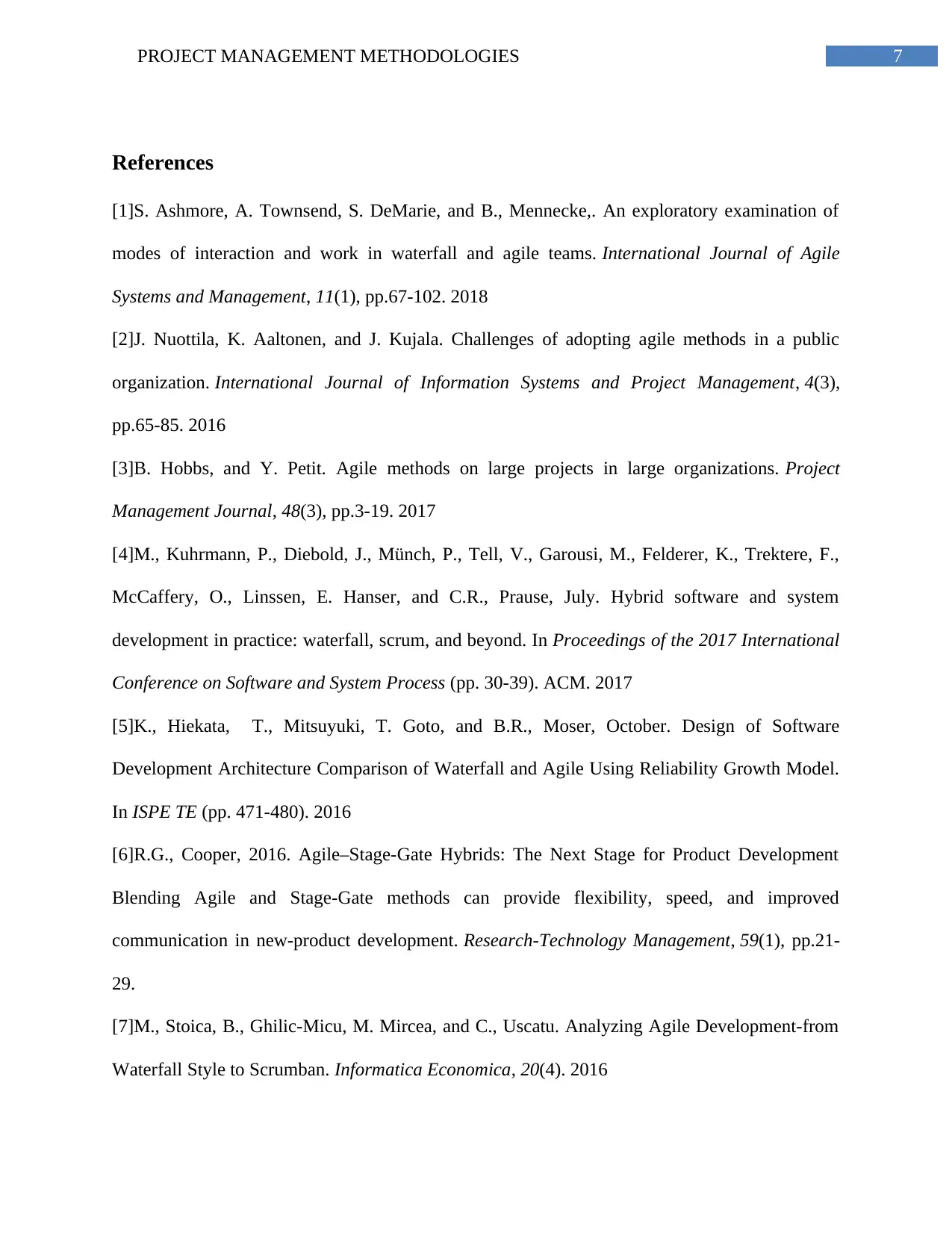
7PROJECT MANAGEMENT METHODOLOGIES
References
[1]S. Ashmore, A. Townsend, S. DeMarie, and B., Mennecke,. An exploratory examination of
modes of interaction and work in waterfall and agile teams. International Journal of Agile
Systems and Management, 11(1), pp.67-102. 2018
[2]J. Nuottila, K. Aaltonen, and J. Kujala. Challenges of adopting agile methods in a public
organization. International Journal of Information Systems and Project Management, 4(3),
pp.65-85. 2016
[3]B. Hobbs, and Y. Petit. Agile methods on large projects in large organizations. Project
Management Journal, 48(3), pp.3-19. 2017
[4]M., Kuhrmann, P., Diebold, J., Münch, P., Tell, V., Garousi, M., Felderer, K., Trektere, F.,
McCaffery, O., Linssen, E. Hanser, and C.R., Prause, July. Hybrid software and system
development in practice: waterfall, scrum, and beyond. In Proceedings of the 2017 International
Conference on Software and System Process (pp. 30-39). ACM. 2017
[5]K., Hiekata, T., Mitsuyuki, T. Goto, and B.R., Moser, October. Design of Software
Development Architecture Comparison of Waterfall and Agile Using Reliability Growth Model.
In ISPE TE (pp. 471-480). 2016
[6]R.G., Cooper, 2016. Agile–Stage-Gate Hybrids: The Next Stage for Product Development
Blending Agile and Stage-Gate methods can provide flexibility, speed, and improved
communication in new-product development. Research-Technology Management, 59(1), pp.21-
29.
[7]M., Stoica, B., Ghilic-Micu, M. Mircea, and C., Uscatu. Analyzing Agile Development-from
Waterfall Style to Scrumban. Informatica Economica, 20(4). 2016
References
[1]S. Ashmore, A. Townsend, S. DeMarie, and B., Mennecke,. An exploratory examination of
modes of interaction and work in waterfall and agile teams. International Journal of Agile
Systems and Management, 11(1), pp.67-102. 2018
[2]J. Nuottila, K. Aaltonen, and J. Kujala. Challenges of adopting agile methods in a public
organization. International Journal of Information Systems and Project Management, 4(3),
pp.65-85. 2016
[3]B. Hobbs, and Y. Petit. Agile methods on large projects in large organizations. Project
Management Journal, 48(3), pp.3-19. 2017
[4]M., Kuhrmann, P., Diebold, J., Münch, P., Tell, V., Garousi, M., Felderer, K., Trektere, F.,
McCaffery, O., Linssen, E. Hanser, and C.R., Prause, July. Hybrid software and system
development in practice: waterfall, scrum, and beyond. In Proceedings of the 2017 International
Conference on Software and System Process (pp. 30-39). ACM. 2017
[5]K., Hiekata, T., Mitsuyuki, T. Goto, and B.R., Moser, October. Design of Software
Development Architecture Comparison of Waterfall and Agile Using Reliability Growth Model.
In ISPE TE (pp. 471-480). 2016
[6]R.G., Cooper, 2016. Agile–Stage-Gate Hybrids: The Next Stage for Product Development
Blending Agile and Stage-Gate methods can provide flexibility, speed, and improved
communication in new-product development. Research-Technology Management, 59(1), pp.21-
29.
[7]M., Stoica, B., Ghilic-Micu, M. Mircea, and C., Uscatu. Analyzing Agile Development-from
Waterfall Style to Scrumban. Informatica Economica, 20(4). 2016
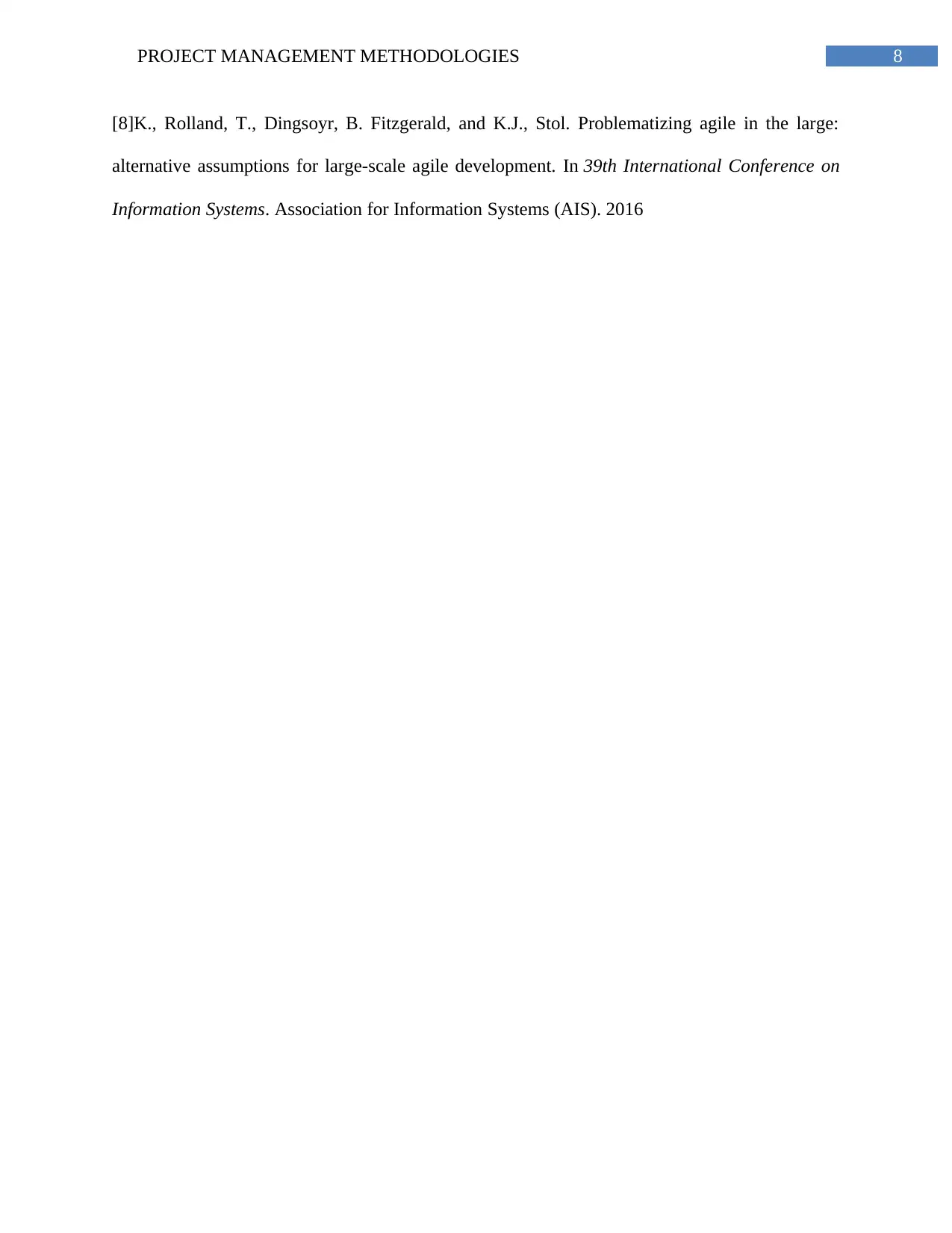
8PROJECT MANAGEMENT METHODOLOGIES
[8]K., Rolland, T., Dingsoyr, B. Fitzgerald, and K.J., Stol. Problematizing agile in the large:
alternative assumptions for large-scale agile development. In 39th International Conference on
Information Systems. Association for Information Systems (AIS). 2016
[8]K., Rolland, T., Dingsoyr, B. Fitzgerald, and K.J., Stol. Problematizing agile in the large:
alternative assumptions for large-scale agile development. In 39th International Conference on
Information Systems. Association for Information Systems (AIS). 2016
⊘ This is a preview!⊘
Do you want full access?
Subscribe today to unlock all pages.

Trusted by 1+ million students worldwide
1 out of 9
Related Documents
Your All-in-One AI-Powered Toolkit for Academic Success.
+13062052269
info@desklib.com
Available 24*7 on WhatsApp / Email
![[object Object]](/_next/static/media/star-bottom.7253800d.svg)
Unlock your academic potential
Copyright © 2020–2025 A2Z Services. All Rights Reserved. Developed and managed by ZUCOL.



